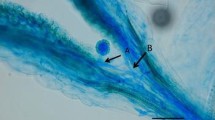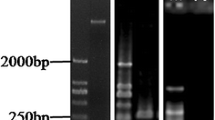Summary
A previously identified S-linked stylar-inactivation PSC factor (Flaschenriem and Ascher 1979b) was studied for its location relative to S. Plants exhibiting complete stylar-inactivation PSC were those with higher multigenic PSC background level than plants with only S-linked partial stylar-inactivation PSC. A pollen-mediated pseudo-self compatibility (PMPSC) adjustment factor was offered as a device to focus on stylar-inactivation PSC by removing some male origin, multigenic PSC. The stylar inactivation factor was not tightly linked to S but affected expression of only the allele to which it was linked. A three part interacting association of genetic material governing self incompatibility (SI) is proposed. The parts of S are the SI identity gene, S-specific PSC genes and, finally, PSC genes which are not S-specific in action. The complete association is termed the SI-complex.
Similar content being viewed by others
References
Atwood SS (1945) The behavior of the self-incompatibility factor and its relation to breeding methods in Trifolium repens. J Am Soc Agron 37:991–1004
Bali PN (1971) Self-incompatibility alleles of Petunia axillaris (Lam.). PSP Hort Res 11:113–115
Brieger F (1927) Über genetische Pseudofertilität bei der selbststerilen Nicotiana sanderae hort. Biol Zentralbl 47:122–128
Dana MN (1982) Studies on the nature of pseudo-self compatibility and the self-incompatibility complex in Petunia hybrida hort. PhD Thesis, University of Minnesota
Dana MN, Ascher PD Sexually localized expression of pseudo-self compatibility (PSC) in Petunia X hybrida hort. 1. Pollen inactivation. Theor Appl Genet 71:573–577
Denward T (1963) The function of the incompatibility alleles in red clover (Trifolium pratense L.). 3. changes in the S-specificity. Hereditas 49:285–329
East EM, Mangelsdorf AJ (1926) Studies on self-sterility. 7. Heredity and selective pollen tube growth. Genetics 11:466–481
Ferrari TE, Wallace DH (1977) A model for self-recognition and regulation of the incompatibility response of pollen. Theor Appl Genet 50:211–225
Flaschenriem DR (1978) Self-incompatibility studies of Petunia hybrida Inheritance and selection for use in F1 hybrid production. PhD Thesis, University of Minnesota
Flaschenriem DR, Ascher PD (1979 a) Pollen tube expression of pseudo-self-compatibility (PSC) in Petunia hybrida. Theor Appl Genet 54:97–101
Flaschenriem DR, Ascher PD (1979 b) S-allele discrimination in styles of Petunia hybrida bearing stylar conditioned pseudo-self-compatibility. Theor Appl Genet 55:23–38
Flaschenriem DR, Ascher PD (1980) Progeny testing for self incompatibility in inbred lines of Petunia hybrida. Hort Science 15:26–27
Harland SC, Atteck OS (1933) The inheritance of self-sterility in Petunia violacea. Genetica 15:89–105
Henny RJ, Ascher PD (1976) The inheritance of pseudo-self-compatibility (PSC) in Nemesia strumosa Benth. Theor Appl Genet 48:185–195
Kojan S (1950) Some further studies of incompatibilities in Petunia axillaris. Bull Torrey Bot Club 77:94–102
Lewis D (1948) Structure of the incompatibility gene. 1. Spontaneous mutation rate. Heredity 2:219–236
Lewis D (1949) Structure of the incompatibility gene. 2. Induced mutation rate. Heredity 3:339–355
Lewis D (1954) Comparative incompatibility in angiosperms and fungi. Adv Genet 6:235–285
Lewis D (1958) Gene control of specificity and activity: loss by mutation and restoration by complementation. Nature 182:1620–1621
Lewis D (1960) Genetic control of specificity and activity of the S antigen in plants. Proc R Soc London, Ser B 151:468–477
Lewis D, Crowe LK (1953) Theory of revertible mutations. Nature 171:501
Lewis D, Crowe LK (1954) Structure of the incompatibility gene. 4. Types of mutations in Prunus avium L. Heredity 8:357–363
Linskens HF (1965) Biochemistry of incompatibility. In: Geerts SJ (ed) Proc 11th Int Congr Genet, Genetics Today 3:629–636
Linskens HF (1975) Incompatibility in Petunia. Proc R Soc London, Ser B 188:299–311
Mather K (1943) Specific differences in Petunia. 1. Incompatibility. J Genet 45:215–235
Natarella NJ, Sink KC (1974) A chromatographic study of phenolics of species ancestral to Petunia hybrida. J Hered 65:85–90
Nettancourt D de, Ecochard R, Perquin MDG, Drift T van der, Westerhof M (1971) The generation of new S alleles at the incompatibility locus of Lycopersicum peruvianum Mill. Theor Appl Genet 41:120–129
Nettancourt D de, Devreux M, Carluccio F, Laneri U, Cresti M, Pacini E, Sarfatti G, Gastel AJG van (1975) Facts and hypotheses on the origin of S mutations and on the function of the S gene in Nicotiana alata and Lycopersicum peruvianum. Proc R Soc London, Ser B 188:345–360
Pandey KK (1956) Mutations of self-incompatibility alleles in Trifolium pratense and T. repens. Genetics 41:327–343
Pandey KK (1959) Mutations of self-incompatibility gene (S) and pseudo-compatibility in angiosperms. Lloydia 22:222–234
Pandey KK (1962) A theory of S gene structure. Nature 196:236–238
Pandey KK (1967) Origin of genetic variability: combinations of peroxidase isozymes determine multiple allelism of the S gene. Nature 213:669–672
Pandey KK (1970) Elements of the S-gene complex. 6. Mutations of the self incompatibility gene, pseudo-compatibility and origin of new incompatibility alleles. Genetica 41:477–516
Qaraeen AM (1980) Pseudo-compatibility in Tradescantia paludosa. 1. Temperature treatment. Hereditas 93:223–229
Robacker CD, Ascher PD (1981) Discriminating styles (DS) and pollen-mediated pseudo-self compatibility (PMPSC) in Nemesia strumosa Benth. 1. Characteristics and inheritance of DS. Theor Appl Genet 60:297–302
Robacker CD, Ascher PD (1982) Discriminating styles (DS) and pollen-mediated pseudo-self compatibility (PMPSC) in Nemesia strumosa Benth. 2. Origin of PMPSC and nature of the DS-PMPSC interaction. Theor Appl Genet 61:289–296
Takahashi H (1973) Genetical and physiological analysis of pseudo-self-compatibility in Petunia hybrida. Jpn J Genet 48:27–33
Townsend CE (1969) Self-compatibility studies with diploid Alsike Clover, Trifolium hybridum L. 4. Inheritance of type II self-compatibility in different genetic backgrounds. Crop Sci 9:443–456
Tseng H-P (1938) Self-sterility in Antirrhinum and Petunia. J Genet 36:127–138
Wergin W (1936) Cyto-genetische Untersuchungen an Petunia hybrida hort. Z Indukt Abstamm Vererbungsl 71:120–155
Author information
Authors and Affiliations
Additional information
Communicated by H. F. Linskens
Scientific Journal Series Paper No. 14. 486 of the Minnesota Agricultural Experiment Station
Rights and permissions
About this article
Cite this article
Dana, M.N., Ascher, P.D. Sexually localized expression of pseudo-self compatibility (PSC) in Petunia X hybrida Hort. Theoret. Appl. Genetics 71, 578–584 (1986). https://doi.org/10.1007/BF00264260
Received:
Accepted:
Issue Date:
DOI: https://doi.org/10.1007/BF00264260




